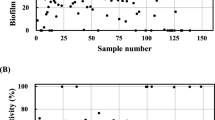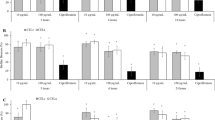Abstract
The aim of this study was to assess the effect of a commercial green tea extract (TEAVIGO™) on the microbial growth of three probiotic strains (Lactobacillus and Bifidobacterium), as well as three pathogenic bacteria. MIC and co-culture studies were performed. The MICs of the green tea extract against Staphylococcus aureus and Streptococcus pyogenes (100 μg ml−1) were considerably lower than those against the probiotic strains tested (>800 μg ml−1) and Escherichia coli (800 μg ml−1). In co-culture studies, a synergistic effect of the probiotic strains and the green tea extract was observed against both Staph. aureus and Strep. pyogenes. Green tea extract in combination with probiotics significantly reduced the viable count of both pathogens at 4 h and by 24 h had completely abolished the recovery of viable Staph. aureus and Strep. pyogenes. These reductions were more significant than the reductions induced by probiotics or green tea extracts used separately. These results demonstrate the potential for combined therapy using the green tea extract plus probiotics on microbial infections caused by Staph. aureus and Strep. pyogenes. As probiotics and the green tea extract are derived from natural products, treatment with these agents may represent important adjuncts to, or alternatives to, conventional antibiotic therapy.


Similar content being viewed by others
References
FAO/WHO (2001) Evaluation of health and nutritional properties of probiotics in food including powder milk with live lactic acid bacteria. Expert consultation report: Cόrdoba, Argentina: Food and Agriculture Organization of the United Nations and World Health Organization, 1–4 October 2001
Finch RG (1998) Antibiotic resistance. J Antimicrob Chemother 42:125–128
Goossens D, Jonkers D, Stobberingh E, van den Bogaard A, Russel M, Stockbrugger R (2003) Probiotics in gastroenterology: indications and future perspectives. Scand J Gastroenterol 38:15–23
Goto K, Kanaya S, Ishigami T, Hara Y (1999) Effects of tea polyphenols on fecal conditions, part 2. The effects of tea catechins on fecal conditions of elderly residents in a long-term care facility. J Nutr Sci Vitaminol 45:135–141
Mack DR, Lebel S (2004) Role of probiotics in the modulation of intestinal infections and inflammation. Curr Opin Gastroenterol 20:22–26
Nakane H, Ono K (1990) Differential inhibitory effects of some catechin derivatives on the activities of human-immunodeficiency-virus reverse-transcriptase and cellular deoxyribonucleic and ribonucleic-acid polymerases. Biochemistry 29:2841–2845
O’Sullivan GC, Kelly P, O’Halloran S, Collins C, Collins JK, Dunne C, Shanahan F (2005) Probiotics: an emerging therapy. Curr Pharmaceut Des 11:3–10
Otake S, Makimura M, Kuroki T, Nishihara Y, Hirasawa M (1991) Anticaries effects of polyphenolic compounds from Japanese green tea. Caries Res 25:438–443
Sakanaka S, Juneja LR, Taniguchi M (2000) Antimicrobial effects of green tea polyphenols on thermophilic spore-forming bacteria. J Biosci Bioeng 90:81–85
Silver L, Bostian K (1990) Screening of natural-products for antimicrobial agents. Eur J Clin Microbiol 9:455–461
Su P, Henriksson A, Mitchell H (2007) Prebiotics enhance survival and prolong the retention period of specific probiotic inocula in an in vivo murine model. J Appl Microbiol 103:2392–2400
Sullivan A, Nord CE (2005) Probiotics and gastrointestinal diseases. J Intern Med 257:78–92
Taguri T, Tanaka T, Kouno I (2006) Antibacterial spectrum of plant polyphenols and extracts depending upon hydroxyphenyl structure. Biol Pharm Bull 29:2226–2235
Toda M, Okubo S, Ikagai H, Suzuki T, Suzuki Y, Hara Y, Shimamura T (1992) The protective activity of tea catechins against experimental-infection by Vibrio-Cholerae O1. Microbiol Immunol 36:999–1001
Yoda Y, Hu ZQ, Zhao WH (2004) Different susceptibilities of Staphylococcus and Gram-negative rods to epigallocatechin gallate. J Infect Chemotherapy 10:55–58
Author information
Authors and Affiliations
Corresponding author
Rights and permissions
About this article
Cite this article
Su, P., Henriksson, A., Nilsson, C. et al. Synergistic effect of green tea extract and probiotics on the pathogenic bacteria, Staphylococcus aureus and Streptococcus pyogenes . World J Microbiol Biotechnol 24, 1837–1842 (2008). https://doi.org/10.1007/s11274-008-9682-x
Received:
Accepted:
Published:
Issue Date:
DOI: https://doi.org/10.1007/s11274-008-9682-x




